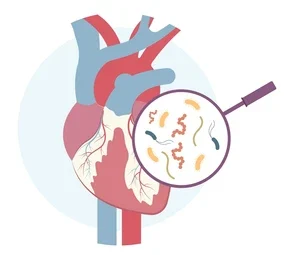Exploring Endocarditis: Symptoms, Causes, and Treatment
What is Endocarditis? Endocarditis is a rare but serious infection of the inner lining of the heart chambers and heart valves (endocardium). It is typically caused by bacteria or, less commonly, fungi entering the bloodstream and attaching to damaged areas of the heart lining or heart valves. Endocarditis can lead to complications such as heart valve damage, heart failure, or septic emboli, making early diagnosis and treatment crucial.
Symptoms of Endocarditis:
- Fever: Persistent fever is a common symptom, often accompanied by chills or sweats.
- Heart Murmur: An abnormal heart murmur may be detected during a physical examination.
- Fatigue: Unexplained fatigue or weakness may occur, often accompanied by a general feeling of illness.
- Joint Pain: Pain and swelling in the joints, known as arthralgia, may occur in some cases.
- Shortness of Breath: Difficulty breathing or shortness of breath, especially during physical activity, may develop as the infection progresses.
- Skin Changes: Small, painless spots on the skin or under the nails, known as petechiae or splinter hemorrhages, may be present.
- Other Symptoms: Additional symptoms may include night sweats, weight loss, headache, or abdominal pain.
Causes of Endocarditis:
- Bacterial Infections: The most common cause of endocarditis is bacteria entering the bloodstream and attaching to damaged areas of the heart lining or heart valves. Dental procedures, invasive medical procedures, or skin infections can increase the risk of bacterial entry into the bloodstream.
- Risk Factors: Factors that increase the risk of developing endocarditis include pre-existing heart valve abnormalities or defects, congenital heart disease, a history of endocarditis, or intravenous drug use.
Diagnosis of Endocarditis:
- Physical Examination: A healthcare provider may listen for abnormal heart sounds (murmurs) and examine the skin for signs of petechiae or splinter hemorrhages.
- Blood Tests: Blood cultures are performed to identify the presence of bacteria or fungi in the bloodstream.
- Imaging Studies: Echocardiography, including transthoracic echocardiography (TTE) or transesophageal echocardiography (TEE), may be used to visualize heart structures and detect abnormalities consistent with endocarditis.
Treatment of Endocarditis:
- Antibiotic Therapy: Intravenous antibiotics are the mainstay of treatment for bacterial endocarditis. The specific antibiotic regimen is tailored based on the identified pathogen and its susceptibility to antibiotics.
- Surgical Intervention: In cases of severe valve damage or complications such as heart failure, septic emboli, or abscess formation, surgical repair or replacement of the affected heart valve may be necessary.
- Long-term Monitoring: Patients with endocarditis require close monitoring by a multidisciplinary team, including infectious disease specialists and cardiologists, to assess response to treatment, monitor for complications, and prevent recurrence.
Conclusion: Endocarditis is a serious infection of the heart lining and valves that requires prompt diagnosis and treatment to prevent complications and optimize outcomes. By recognizing the symptoms, understanding the causes, and seeking timely medical evaluation, individuals at risk for endocarditis can receive appropriate management and reduce the risk of long-term complications. If you or someone you know experiences symptoms suggestive of endocarditis, it is essential to seek medical attention promptly for further evaluation and management.




